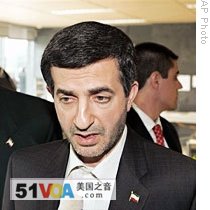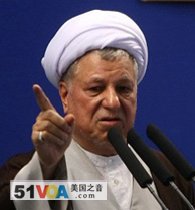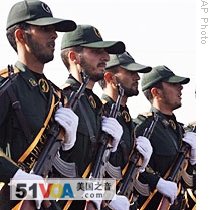Washington
27 July 2009
The street protests in Iran have faded in the face of the government's security crackdown. But the political squabbles and bickering continue. Internal feuds that were once kept behind closed doors have erupted into the open, providing a rare glimpse of political tensions in the Islamic Republic.
Suzanne Maloney of the Saban Center for Middle East Policy told a recent congressional hearing that the level of squabbling among Iran's political heavyweights is unprecedented.
 |
| Iranian supreme leader Ayatollah Ali Khamenei, 06 Jul 2009 |
When President Mahmoud Ahmadinejad was ordered by Supreme Leader Ali Khamenei to drop his choice of Rahim Esfandiar Mashaei to be first vice-president, he initially refused.
 |
| Rahim Mashaei (File) |
Then on Sunday, with his re-inauguration on the horizon, he fired his hardline intelligence minister and the culture minister resigned. No official reasons were given for the moves. But, according to the English-language Tehran Times, both men had strongly objected to the Mashaei vice-presidential appointment.
On Sunday, Mr. Ahmadinejad also appointed Ali Kordan as special inspector. Kordan resigned as interior minister last year after it emerged that his claim of an Oxford University law degree was false. Kordan's new job is to investigate fraud and corruption in government.
Analysts say the president is also facing internal pressure from reformists as well as conservatives. Middle East analyst Reva Bhalla of the private intelligence firm Stratfor says former president Ali Akbar Hashemi Rafsanjani - who is one of President Ahmadinejad's chief political rivals - is trying to limit the president's ability to politically maneuver in office.
 |
| Iranian influential cleric and former president Akbar Hashemi Rafsanjani delivers his sermon during Friday prayers at Tehran University in the Iranian capital, 17 Jul 2009 |
Stanford University director of Iranian Studies Abbas Milani says the opposition itself is split.
"I think the opposition, in my mind, is divided in two groups. Some, like Rafsanjani, are more moderate. Rafsanjani, I think, wants a more refined version of the status quo. Mousavi and the rest of them, although they have not articulated, I think want a return, some of them have implicitly said they want a return, to the first draft of the constitution," said Milani.
That first draft of the 1979 constitution did not confer any special role to the clergy or contain any reference to velayat-e faqih, the concept under which final state authority rests with one religious leader.
The balance of power could rest in the hands of the powerful Iran Revolutionary Guard Corps. The Revolutionary Guard was created in 1979 because the leader Ayatollah Khomenei did not trust the military. It is a parallel force, separate from the regular military with its own ground, sea, and air units. It has also has internal security functions, it controls the Basij militia, and has built up considerable economic power as well. President Ahmadinejad is a Revolutionary Guard veteran.
 |
| Iranian Revolutionary Guards members march during a parade ceremony outside Tehran (file photo) |
"What would truly be devastating for Khamenei and Ahmadinejad would be fissures among the regime's security forces, mainly the Revolutionary Guards. So far, we have not seen that, but the Revolutionary Guards are a very large entity, 120,000 men," he said. "And whereas the senior commanders are hand-picked by Khamenei and they are going to likely remain loyal to him, the rank-and-file, both empirically and anecdotally, we have seen, are much more representative of Iranian society at large," he added.
President Ahmadinejad is due to be sworn in for his new term August 5.